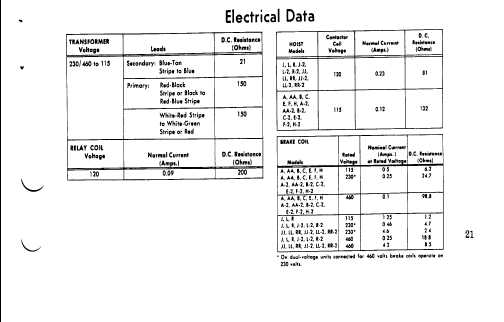TROUBLE
PROBABLE CAUSE
CHECK AND REMEDY
12
Hoist will not
a)
Open circuit
a) See Item 11a.
operate at fast
b)
Open speed selecting
b) Open or shorted winding in speed select-
speed in either
control circuit
ing contractor coil. Loose connection or
direction
broken wire in circuit. Mechanical bind-
ing in contactor. Control station contacts
not making or opening. Replace coil;
repair connection, contactor or control
station.
c)
Phase failure
c) See Item lb.
13
Hook will not
a)
Excessive load
a) See Item 6b.
raise at slow
b)
Phase failure
b) See Item lb.
speed
c)
Open speed selecting
c) See Item 12b.
control circuit.
d)
Brake not releasing
d) See Item lg.
14
Hook will not
a)
Phase failure
a) See Item lb.
lower at slow
b)
Open speed selecting
b) See Item 12b.
speed
control circuit.
c)
Brake not releasing
c) See Item lg.
15
Hook will not
a)
Excessive load
a) See Item 6b.
raise at fast
b)
Phase failure
b) See Item lb.
speed
c)
Brake not releasing
c) See Item lg.
16
Hook will not
a)
Phase failure
a) See Item 6b.
lower at fast
b)
Brake not releasing
b) See Item lg.
speed.
17
Hook moves in
a)
Phase reversal
a) Wiring reconnected improperly Inter-
proper direction
change two leads of motor winding that is
at one speed -
out of phase at the speed selecting relay.
wrong direction
at other speed.
To Detect Open and Short Circuits In Electrical Components
Open circuits in the coils of electrical components may be detected by isolating the coil and checking for
continuity with an ohmmeter or with the unit in series with a light or bell circuit.
Shorted turns are indicated by a current draw substantially above normal (connect ammeter in series with
suspected element and impose normal voltage) or D. C. resistance substantially below normal. The current method is
recommended for coils with very low D. C. resistance.
Motor current draw in the stator should be measured with the rotor in place and running. Brake, relay and
contactor coil current should be measured with the core iron in operating position.
21

